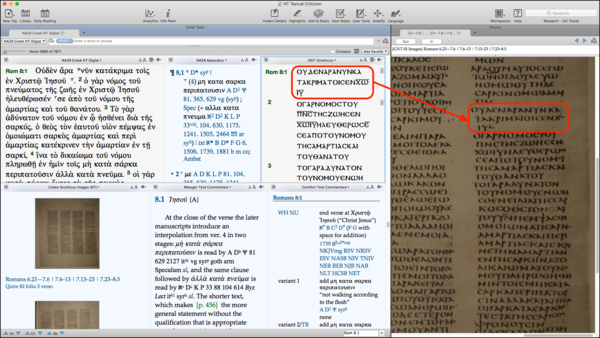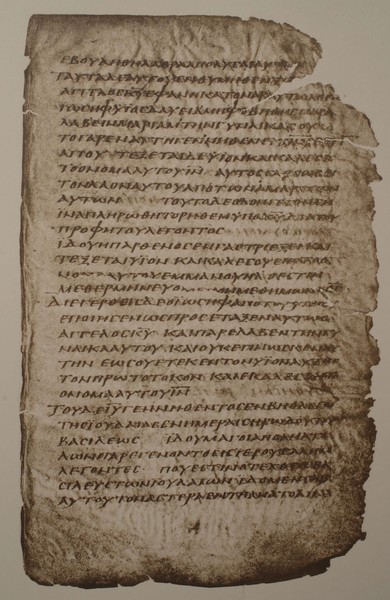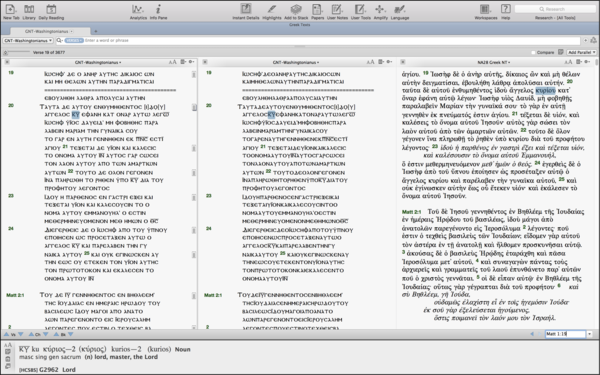In the 1990s I took a New Testament textual criticism class under John B. Polhill as an elective in my MDiv studies. Looking back, it remains in my recollection as one of the best classes I experienced during that time. I learned more about the origin and transmission of the New Testament in that course than in any other class I took. I found everything about the subject fascinating and still do.
At that time, although Accordance was newly available, this was still the early days for Bible software. There were biblical texts—both original languages and translations—as well as many of the standard lexicons and other reference works, but not too much beyond that. In my class, we primarily depended on the print works of scholars like Bruce Metzger as well as the immense knowledge of Dr. Polhill on the subject.
Although I trusted both Metzger and Polhill, that dependence I mentioned above was very real. We could ask questions in class and consult related reference works, but there wasn’t much more we were able to do on our own. In the previous Student Strategies blog post, I discussed using Accordance for doing one’s own research (as opposed to depending on the research of others) with the INFER search. In this post I’d like to introduce (or remind) students to the features in Accordance that allows them to do their own text critical work. While perhaps not the same as holding an ancient manuscript in your hand, Accordance’s text-critical resources may just be the next best thing.
I’m going to use the Greek New Testament for the examples that follow, but note that we also have resources for textual criticism of the Hebrew Bible.
Let’s assume you don’t want to reinvent the wheel by traveling all around the world and examining all extant manuscripts for yourself, allowing you to create your own eclectic text. More than likely, you would start with the apparatus for the UBS 5 or Nestle-Aland 28 New Testament. Perhaps then, from what you find in the apparatus, you might want to consult a particular manuscript yourself. Although we obviously can’t give you access to every extant manuscript, we do provide the tools for examining the major witnesses that form the basis of the NA/UBS New Testament.
If you want to see what the image itself looks like, you’ll want to check out the Greek MSS Images from CSNTM, which contains the following manuscripts: Codex Alexandrinus, Codex Sinaiticus, Codex 2882, Codex Vaticanus, and Codex Washingtonianus (note that for study of the Hebrew Bible, we offer images for the Dead Sea Scrolls, Leningrad Codex, and Codex Sinaiticus).
Above: Matt 1:19 – 2:2 from Codex Washingtonianus. This image was exported from Accordance at 2600 x 4000 pixels.
These manuscripts, reproduced at high resolution, allow you to zoom in and look closely at these ancient texts. This is especially helpful for debated readings. Rather than citing a third party, you can write in your class paper, “Having looked at a high-resolution facsimile image of the codex, I conclude… .” And you can also copy or export the images for illustration in your paper or in a presentation using software like PowerPoint or Keynote.
In addition to these images, Accordance also offers a set of fully digitized text, Codex Add-On, corresponding to the physical manuscripts. This set uses an uncial (capital) font designed specifically for the included manuscripts: Codex Alexandrinus, Codex Bezae, Codex Sinaiticus, Codex Vaticanus, Codex Washingtonianus, as well as a Greek New Testament Papyri module based on the 2nd edition of Comfort & Barrett’s The Text of the Earliest New Testament Greek Manuscripts. The uncial font can be used in your work as well to represent the text of the ancient manuscripts.
Above: Codex Washingtonianus with spaces (left column) and without spaces (center column) in parallel with the NA28 Greek New Testament. Note Crossover Highlighting between all three texts.
These digitized texts are morphologically tagged and have line breaks corresponding to the end of the line in the original codices. There are even representations of the Nomina Sacra used these manuscripts. Moreover, spaces between words can be turned on and off. Since the earliest manuscripts did not include spaces between words, removing the spaces gives you a better idea of what the original readers viewed–but in a much more readable digital font! The images can be viewed and scrolled in parallel with the digitized texts, as well as the UBS or NA Greek New Testament. Since the uncial texts are morphologically tagged, crossover highlighting works between them the UBS/NA texts.
I’m still amazed to have this kind of access to ancient texts. Yes, all the standard reference works are indispensable, but there’s nothing quite like doing your own textual criticism and verifying readings for yourself (and it will impress your instructors, too!).
There are many more resources in Accordance related to textual criticism, including alternative apparatuses—too much content to go into here. However, check out Tim Jenney’s webinar from a couple of years ago, “Greek New Testament Textual Criticism,” to see some of these tools in action and to be introduced to some of the other text-critical resources not mentioned here.
Don’t miss previous installments in our Strategies for Students series!
#1 Take Class Notes in Accordance
#2 Use Accordance Editions of Textbooks
#3 Export Citations from Accordance




